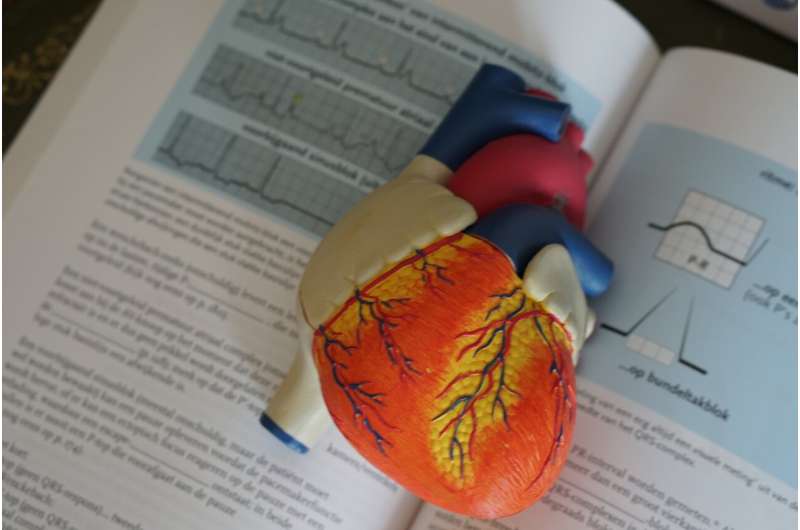This article has been reviewed according to Science X's editorial process and policies. Editors have highlighted the following attributes while ensuring the content's credibility:
fact-checked
trusted source
proofread
Novel score predicts heart failure improvement after atrial fibrillation ablation

A score based on four readily available clinical and imaging parameters identifies the heart failure patients who benefit most from atrial fibrillation ablation, according to late breaking science presented at EHRA 2023, a scientific congress of the European Society of Cardiology (ESC).
Atrial fibrillation and heart failure often coexist. It is estimated that approximately 30% of patients with heart failure will develop atrial fibrillation and patients with atrial fibrillation have a five-fold increased risk of developing heart failure. Each condition aggravates the prognosis of the other. Atrial fibrillation patients who develop heart failure have a three-fold increased risk of death, while in heart failure patients, the risk of death is two-fold higher when atrial fibrillation is also present.
Medium-sized randomized trials have produced mixed evidence on the benefit of ablation in patients with heart failure, with outcomes largely depending on the selection and characteristics of patients. Therefore, there is uncertainty about which heart failure patients should be referred for ablation. ESC Guidelines on atrial fibrillation recommend the procedure to reverse left ventricular dysfunction in atrial fibrillation patients when tachycardia-induced cardiomyopathy is highly probable. In addition, catheter ablation should be considered in selected atrial fibrillation patients with heart failure and reduced ejection fraction to improve survival and reduce heart failure hospitalization.
"The tools to help clinicians determine who exactly these selected patients are and which patients have tachycardia-mediated cardiomyopathy are elusive and often subjective," said principal investigator Dr. Marco Bergonti of the Cardiocentro Ticino Institute—EOC, Lugano, Switzerland and a Ph.D. student at the University of Antwerp, Belgium. "Further evidence is needed to help stratify and identify those patients who will most likely benefit from atrial fibrillation ablation. The Antwerp score was developed to predict the response to ablation in heart failure patients with impaired (below 50%) ejection fraction."
The score is based on four parameters: QRS width above 120 milliseconds (2 points), known etiology (2 points), paroxysmal atrial fibrillation (1 point) and severe atrial dilation (1 point). Total scores range from 0 to 6, with 0 indicating a greater likelihood of recovery. A previous single-center study by the ANTWOORD investigators showed that the ANTWERP score estimated the probability of left ventricular ejection fraction (LVEF) recovery after ablation of atrial fibrillation.
The current ANTWOORD study aimed to externally validate the ANTWERP score in a large European multicenter cohort. The researchers retrospectively identified patients with heart failure, impaired LVEF and atrial fibrillation who had an ablation procedure at eight centers in Europe. Participants underwent echocardiography to assess LVEF before ablation and 12 months afterwards. The primary endpoint was sufficient improvement in ejection fraction at the 12-month echocardiography to be considered a "Responder" to treatment. Responders were defined according to the 2021 universal definition of heart failure: 1) in patients with a baseline LVEF of 40–50%, an LVEF increase to 50% or more; 2) in those with a baseline LVEF of 40% or below, an increase in LVEF of at least 10% from baseline, and a second measurement of LVEF above 40%.
The study included 605 patients. The average age was 61 years and 24% were women. Some 427 patients (70%) were classified as responders and were more likely to have positive ventricular remodeling (odds ratio [OR] 8.9, p<0.001), fewer heart failure hospitalizations (OR 0.09, p<0.001) and lower mortality (OR 0.11, p<0.001) compared to non-responders. The Antwerp score predicted LVEF improvement after ablation with an area under the curve of 0.86 (95% confidence interval 0.82–0.89; p<0.001). For total scores of 0, 1, 2, 3, 4, and 5-6, the proportion of responders was 94%, 92%, 82%, 51%, 40% and 17%, respectively.
Dr. Bergonti said, "Based on our findings, patients with a low score (2 or less) may benefit from early referral for catheter ablation, with a more than 90% chance of recovery. Patients with a high score (5 or higher) have a very low expected recovery rate (below 20%) and hence may benefit more from alternative strategies such as aggressive rate control. Those in the intermediate zone (score 3-4, expected recovery rate 47%) may benefit from further diagnostic tests such as cardiac magnetic resonance to improve their diagnostic assessment, as the presence of late gadolinium enhancement has been associated with less LVEF improvement."



















